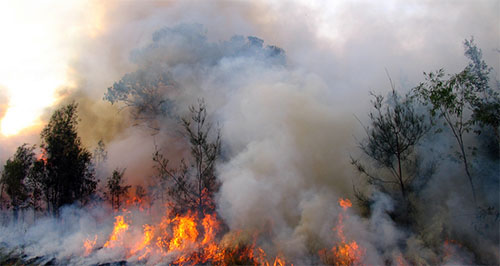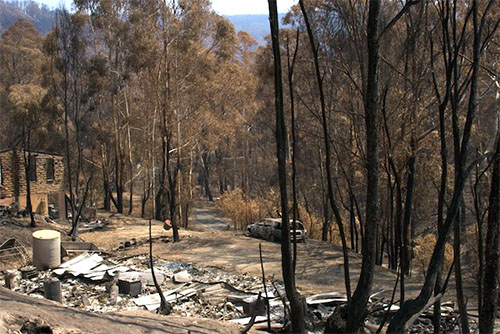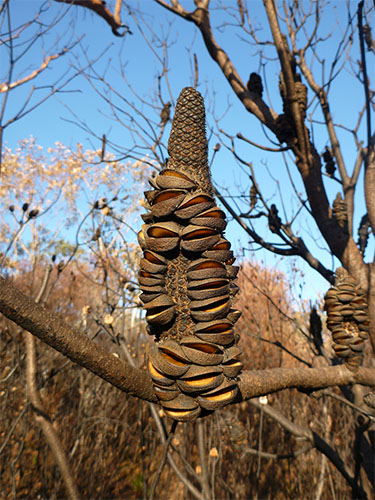

| Archive Blog Cast Forum RSS Books! Poll Results About Search Fan Art Podcast More Stuff Random |
|
Classic comic reruns every day
|
1 {photo of a large bushfire}
1 Caption: Bushfire
|
First (1) | Previous (3306) | Next (3308) || Latest Rerun (2891) |
Latest New (5380) First 5 | Previous 5 | Next 5 | Latest 5 Annotations theme: First | Previous | Next | Latest || First 5 | Previous 5 | Next 5 | Latest 5 This strip's permanent URL: http://www.irregularwebcomic.net/3307.html
Annotations off: turn on
Annotations on: turn off
|
 Creative Commons Attribution-Share Alike image by Bert Knottenbeld. |
Similar things are known elsewhere as forest fires or brush fires. Bushfire is fire in the Australian bush. ("Bush" is a word with several meanings. It can mean "wilderness" in general, including scrubland and even desert, or it can mean "forest" specifically. It can also mean "rural areas", as opposed to city areas, and so encompass farmland. Context is everything.)[1]
Bushfires can be started by lightning strikes. Once started, they can grow rapidly and be near impossible to put out if the weather conditions are right. With human civilisation nearby, the number of ways a bushfire can start increases alarmingly. People drop cigarette butts. Car backfires can spark dried leaves in a gutter. Embers can escape from barbecues. Wind can blow down live power lines, creating sparks. People can, stupidly, light bushland on fire on purpose.
Fire needs three things. Fuel to burn. Heat, to sustain the chemical reaction. And oxygen to react with the fuel. Combustion is a chemical process in which elements in the fuel combine with oxygen, creating oxidised compounds. This releases chemical energy because the binding energy of the oxides is generally high compare to the binding energies of the various compounds in the fuel.
 Creative Commons Attribution-Share Alike image by Bert Knottenbeld. |
Heat is supplied initially by the source of ignition, be it a lightning strike or a cigarette butt. Once a fire has begun, the reaction produces enough heat to ignite adjacent material, and the fire can spread. Ignition is easier if the fuel is dry and warm, rather than damp or cold. So hot, dry weather helps fires both in getting started and in spreading.
Oxygen comes from the air. Once a fire reaches a certain size, it is the amount of available oxygen that limits how fast and hot it can burn. The fire uses much of the oxygen in the air immediately around it and becomes reliant on incoming oxygen from air currents. If the weather is windy, this helps a large fire in two different ways. Firstly, it blows more oxygen on to the fire, allowing it to burn faster and ignite more fuel. Secondly, it blows heat and embers downwind, spreading the source of ignition to more fuel in that direction.
The combination of an abundance of dry plant material and dry, warm, windy weather provides the ideal conditions for spreading a bushfire like... well, like wildfire. Once started in such conditions, a fire can be almost impossible to put out, despite the best efforts of an army of firefighters armed with modern equipment.
 Fire burning near properties. Creative Commons Attribution image by Flickr user thinboyfatter. |
To prevent buildings being threatened, people can clean out gutters, remove loose combustible material from around the premises, and hose everything down with water to make it damp and hard to ignite. Hot windy weather again makes this less effective, blowing debris around and drying up any moisture quickly.
Firefighters have various tactics for dealing with the advance of a bushfire. Water is a major one. It can put out flames and make fuel too damp to burn easily. The problem is delivering enough of it to be effective. Hoses can only deal with fire up to a certain size, so are restricted to the fringe of a fire front and putting out spot fires before they become established. Planes and helicopters can drop loads of water over a fire, but even this amount often only serves to extinguish patches within a large fire.
Another important tactic is to remove fuel from the path of the advancing fire, by back-burning. This is deliberately setting fire to fuel ahead of the fire front, hopefully in a more controlled way, to create a region with very little left that can burn. If the fire reaches this firebreak, it is more difficult for it to keep advancing - though not impossible, as embers can ignite spot fires across even fairly wide firebreaks. Roads form firebreaks, and often this is where back-burning begins, to widen the break that already exists. When a fire crosses a road, it can be a bad blow for firefighters, as the fire has new swathes of forest to burn through.
 Remains of houses and car after a bushfire. Creative Commons Attribution-NonCommercial-ShareAlike image by Stuart Murdoch. |
Heat is the immediate danger from a fire. A large fire gives out prodigious amounts of heat, and it is difficult to get close to it without insulated protective gear. But people will generally not get dangerously close to a fire if they can help it because the heat will drive them back. A greater danger comes from smoke, which is harder to avoid and which can overwhelm someone suddenly, choking their lungs and making it extremely difficult to breathe. If overcome by smoke, a person can pass out, which can be deadly if the fire is heading towards them. Even if rescued, smoke damage to the lungs can leave someone needing a respirator for days afterwards.
The danger to property can also be catastrophic. Surrounded by a bushfire, or in the direct path of an advancing front, a house has little chance. Anything combustible will burn with a ferocity that also melts metal and collapses brick and concrete, often leaving little more than a pile of rubble and ash. Firefighters try to save properties, but their emphasis has to be on saving lives, getting people out of the danger zone, so sometimes buildings have to take the brunt of the flames.
 Banksia seed cone after a fire. Creative Commons Attribution-ShareAlike image by Doug Beckers. |
But all is not lost. Fire has a renewing property after it has wrought its destruction. Ash is rich in elemental nutrients that new plants need to grow. And many plants have evolved methods to deal with periodic fires sweeping through their habitat. Australian plants in particular have a variety of means of regenerating quickly after a fire. Eucalyptus trees, banksias, and others have hardy lignotubers, protected by a thick layer of woody bark. After a fire, new shoots quickly emerge from these. Banksias also have formidable seed cones which protect the seeds within. The heat of a fire merely serves to weaken the cones enough for the seeds to fall out and sow the ground around the burnt parent tree. In fact some species cannot release their seeds until the cones have been burnt.
And so, within a few years after a major fire, new growth has appeared quickly and the forest begins to re-establish itself.
We humans like to think that we have tamed fire. Various cultures have legends about how the first people domesticated fire. Even the words "tamed" and "domesticated" make fire sound like an animal, rather than a force of nature. We may be able to use it as a tool, and a very useful tool it is when under control. But when out of our control, fire is a rampaging monster that can devastate enormous tracts of land, wiping out plants, animals, and human civilisation. Never underestimate it.
[1] You can see all the bushfires currently burning in my state of New South Wales on this map, which is updated live.
|
LEGO® is a registered trademark of the LEGO Group of companies,
which does not sponsor, authorise, or endorse this site. This material is presented in accordance with the LEGO® Fair Play Guidelines. |